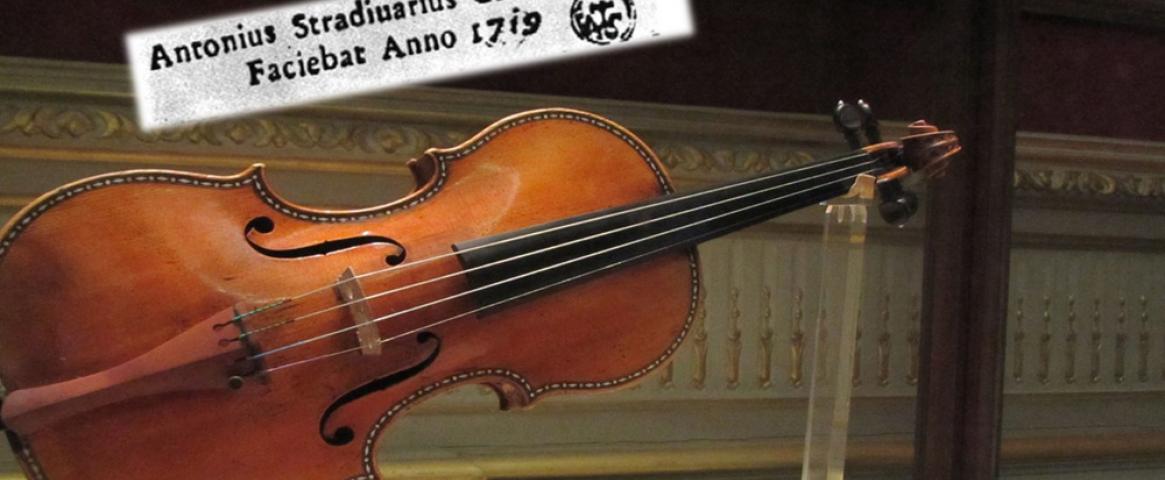By Emily A. Mueller
The inner workings of the most valuable violins in the world remain a mystery to musicians and scientists alike. These violins, made in Cremona, Italy in the 1600s and 1700s, are preferred by top musicians around the globe for their rich sound and playing quality.
But the craftsmen who made them – Amati, Stradivari and Guarneri del Gèsu – kept their instrument making methods as closely guarded secrets. Hundreds of years later, their techniques remain an elusive mystery.
“There’s no historical clue,” says Hwan-Ching Tai, professor of chemical biology and neurochemistry at National Taiwan University. “The field has been searching for 250 years for any kind of record about what they could have done – from all over Europe.”
As a self-proclaimed audiophile, Tai supplements his usual laboratory work with an unexpected side-project — research into the materials properties of Cremonese instruments to unravel the mystery of their legendary sounds.
Tai’s entry into the cryptic world of Cremonese violins began with a road trip. A friend from the California Institute of Technology, where Tai did his doctoral work, had just finished writing a term paper on violin research and wanted to meet Joseph Nagyvary, professor emeritus of biochemistry at Texas A&M University, who kick started this research field in the 1970s. So, over a holiday break, the two flew to Texas to visit some family members, then drove to College Station, Texas, to talk about violins.
Tai recalls that it was completely impulsive.
“That’s what scientists do, spend their Christmas vacation visiting another researcher on a whim,” he says. “But it was really fascinating talking to him and after that meeting, I was captivated by the field.”
Nagyvary’s career at Texas A&M focused on biochemistry but, as a music enthusiast like Tai, he saw the opportunity to use his expertise to study old violins.
“He was the first person to say, ‘Let’s use materials science methods and start to analyze this varnish, the wood, and so on,” says Tai. “He knew that real analytical chemistry could be done, instead of guessing, trial and error.”
When Tai started his own lab in Taiwan, he dedicated part of it to violin research. With his team, he investigates the chemical composition and wood structure of Cremonese instruments. In a June 2021 study in the international edition of the chemistry journal Angewandte Chemie, Tai and his colleagues found high concentrations of different elements in the soundboard wood from several Cremonese instruments that were made over a span of 120 years.
“This suggests that the best violin makers in history treated the wood and added more chemicals, in greater concentrations, over time. So, they expanded chemical treatment by experimenting,” says Tai.
To yield this finding, Tai and his team took samples from old instruments, dissolved them in strong acid, and analyzed each one to determine which elements were present.
They found different concentrations of different substances in samples from each maker: sodium chloride (salt) and potassium for Stradivari, and aluminum and calcium for Guarneri. The researchers speculate that these elements came from wood treatments applied by these craftsmen, possibly in their attempts to improve sound quality or preserve the wood.
“Interestingly, we know that Stradivari and Guarneri instruments have different sounds, but they also have very different chemical recipes,” says Tai. “We cannot prove that they are associated, but it makes you wonder what roles these chemicals play.”
Another unanticipated finding was that the structure of the wood actually changed for samples with high concentrations of minerals. Cellulose, the plant component that makes wood cell walls stiff and strong, exists as tiny helical fibers. Tai and his team used a spectroscopic imaging technique to study the cellulose structure in samples from the old instruments. They found that the expected spectral signal vanished in a sample of spruce wood with high mineral content from the front of a Stradivari cello, a characteristic that had not been previously seen.
According to Tai, “It’s not subtle. Cellulose lost its natural twist.”
He says that understanding how the wood changes with high mineral concentrations could have implications for instrument sound quality and for preserving these instruments as they age.
So, how did Tai get samples from cherished instruments costing millions of dollars?
Most of his samples come from museums or professional violin makers and restorers with whom Tai has fostered close relationships. The samples are minute slivers of wood, painstakingly carved from the interior of an instrument during repairs.
“Some restorers are very careful about protecting these wood shavings for decades just in case someone might be interested in studying them,” says Tai. “For example, the materials in our most recent study were collected in the 1980s.”
One of the biggest challenges in analyzing the samples is defining which aspects of the wood came from the original manufacture of the instruments versus later manipulations.
To mitigate this concern, Tai and his colleagues also studied wood from old buildings and from old violins that were not famous. They did not find the same levels of minerals or changes in wood structure in these samples as seen in the Cremonese samples.
“They don’t have same the kind of chemical alterations that the Cremonese instruments do, so it’s not just contamination,” he says. “We also tried to mimic the results with our own artificial wood treatments, so we’re pretty sure that the old makers intentionally did heavy chemical treatments.”
The melodic masterpieces from Cremona still present an enigma for researchers, musicians and today’s craftsmen who strive — like the masters they desire to emulate — to create the highest caliber instruments. There is still much, Tai admits, that we don’t know about how the old instruments were built or what sets them apart from top quality modern instruments.
But for the man who is both a music enthusiast and a scientist, everything comes back to performers knowing quality when they feel — and hear — it.
“The people who can best play these priceless instruments from master makers have the most accurate ears,” Tai says. “And it’s not just one violinist. It’s hundreds of violinists over 200 years. I have confidence in that.”
Emily A. Mueller is a Ph.D. student in chemistry at the University of Michigan, where she makes and studies polymers to help flexible solar cells last longer. When she isn't in the lab, you'll probably find her making music with her ordinary (not multimillion dollar) flute or piano, on an adventure outdoors or with her nose in a book.
This story was produced as part of NASW's David Perlman Summer Mentoring Program, which was launched in 2020 by our Education Committee. Mueller was mentored by Michael E. Newman.
One of five violins crafted by Antonio Stradivari on display at the Palacio Real de Madrid. An example of the master’s “geigenzettel” (maker’s label) is seen above the instrument." Credit: Created from public domain images under Wikimedia Commons/CC-BY-SA-3.0



